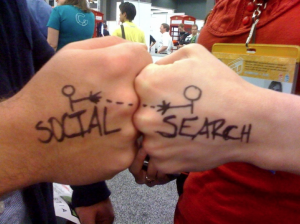 11 days ago I decided to blog every day for 10 days, in an attempt to kickstart myself into writing more online for lots of sensible reasons. It’s gone… OK, I think. The quality has been dramatically variable, which is to be expected: I said at the start I was rusty, and that’s still true. I can hear bits of me creaking when I write. And without the luxury of time to let my writing sit and then come back to edit it, a lot of what’s gone up here has been rough and ready.
11 days ago I decided to blog every day for 10 days, in an attempt to kickstart myself into writing more online for lots of sensible reasons. It’s gone… OK, I think. The quality has been dramatically variable, which is to be expected: I said at the start I was rusty, and that’s still true. I can hear bits of me creaking when I write. And without the luxury of time to let my writing sit and then come back to edit it, a lot of what’s gone up here has been rough and ready.
Despite that, the world has not ended, and my crazy perfectionist brain hasn’t given me too much grief about what I’ve posted. I’ve put something vaguely readable out every day. Some of it’s obviously been interesting – I had more than a thousand views in a day for the IGN piece, which for this blog is a significant number. Some of it’s just me thinking out loud, which is also fine. One of the reasons for doing this was to get better at thinking, after all.
It hasn’t been particularly easy to fit around a standard day. That’s partly because right now there are no standard days – the one real constant is that I’m very busy with work – and partly because I’ve not set aside a set block of time to blog. Days when I spot something first thing in the morning, or when I’ve got something brewing in the back of my head, have been relatively easy – I can knock something into shape over lunch. Days when I’m struggling for a subject or when I can’t get words to flow quite right have been much harder. And if I hadn’t written almost all of this post yesterday, there’s no way I could have gotten it up today.
But that will change as I get back into the groove, and as my magpie habits return. I’m finding myself squirrelling away interesting links for analysis, not just tweeting them and leaving them. I’m reading more deeply, forcing myself to articulate what’s relevant in more depth than 140 characters minus a link. I’m also realising there are lots of things I want to write that need a bit more care and attention than the average day can provide. I’ve not talked about my work, or written that piece about movement in Morrowind and the problem of fast travel, or gotten really snarky about Snowfall-related news commentary. Yet.
So the experiment will continue for a while. I’m not going to commit 100% to posting every day, but when Grant recovers from PAX I am going to ask him to join me in doing this again. If it takes 60 days to build a habit, then perhaps that should be the goal: in 60 days time, I’d like to be blogging more days than not. I’d like to be posting better quality pieces, too, but it’s more important that something exists than that it’s perfect.






